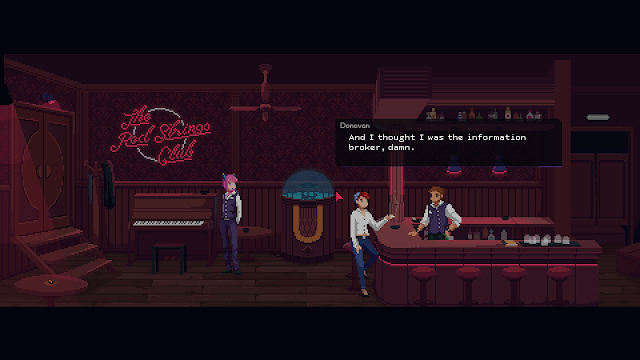Review - The Red Strings Club
How much damage can one bar manage to do? With a bit of magical liquor, you would be surprised. The Red Strings Club is a dialogue focused game that was developed by Deconstructeam and produced by the well known Devolver Digital. It puts the player in control of a few characters in a cyberpunk future of mega corporations, cyborgs, and transhumanism. The game succeeds at making a narrative experience that, I would say, succeeds at using the gaming medium to reveal their themes.
The gameplay is divided up into the player controlling one of three characters: a bartender, a robot, and a grandiose activist. The brunt of the game is comprised of reading and responding to dialogue trees. What separates The Red Strings Club’s dialogue trees from other games is the heavy emphasis on the player interpreting what is being said and, based upon that, choosing an apt response. These dialogue trees are not a matter of just clicking down every possible path. Most of the time the player only gets one chance to ask a question and get whatever information they are looking for. In this way, the constant dialogue is never tedious because the player’s main task in the game is to interpret what is being said to them.
Beyond the dialogue there is not much other gameplay. There is the carving game where the player has to take a lump of clay and carve it into a particular shape, but that only exists in the beginning of the game and is in place more to immerse the player in that particular role than to challenge them. The other gameplay element is the bartending. In it, the player mixes a cocktail in order to invoke some suppressed emotion within the character they are talking to and, in that moment of weakness, suss out some vital piece of information. The actual mixing of drinks is easy with the real challenge being to decide what emotion is best for asking each of the questions the player will have. What this results in is that the dialogue is put in the very forefront with the other gameplay elements being immersive, but ultimately subservient to the dialogue.
By placing dialogue before every other gameplay element, The Red Strings Club created an example of a truly narrative driven game that also succeeds at being engaging. The problem with the majority of other so called “narrative (or story) driven games” is that they either end up being a visual novel, thereby neglecting any meaningful elements of the gaming medium, or the narrative becomes an excuse for gameplay that is non-narrative. The Red Strings Club circumvents the former issue by focusing the dialogue on player interpretation. Each dialogue option is not the typical “click to progress discussion” that is often seen in gaming dialogue, instead each is a puzzle where the player has to gauge the NPC’s emotional state, relationship to the character, personal motives, and prior discussion in order to figure out what to say. In other words, The Red Strings Club figured out how to make a dialogue tree a meaningful gameplay element instead of just being a gimmick to make the world seem more real.
The latter issue is fixed by the fact that The Red Strings Club very clearly put their narrative before any other game element. This can be seen by the fact that every element of the game exists to reinforce themes or as a direct result of narrative elements. There are none of the typical gamey elements that usually show up, such as random mini-games and action sequences that were clearly created by a developer who thought that a game has to have action. I was certainly impressed by the amount of restraint shown by the developers. Their lack of excess mechanics and their focused gameplay made it so that the narrative shined through with no unnecessary interruptions or meaningless, throw away elements. While the gameplay is simple, with an almost L.A. Noire interrogation focus, the effort put into the dialogue and the player’s interactions with it made the experience feel exceptionally well crafted.
The narrative of The Red Strings Club is, in essence, an archetypal cyberpunk narrative. The world is full of technology that, instead of enhancing and bettering human experience, splits them apart. In the city is one last vestige of human experience in the Red Strings Club, a mystical bar with a bartender that can tap into a person’s deepest emotions. The story focuses on the struggle between the organic human elements that are trying to cling to their identity in an alienated world and the sterile, logical modern technocracy that pushes for order by any means. At its heart, the story asks what makes humanity what it is and if any of the essence of humanity is worth losing to better “the greater good.” Unlike many games, The Red Strings Club tackles these questions head on, actively asking the player difficult questions along the way.
This is all well and good, but difficult questions and cyberpunk narratives exist in other games. Where The Red Strings Club differentiates itself from the crowd is that it utilizes narrative elements that are exclusive to gaming. The first way that it does so is by creating a meaningful branching storyline. The player’s decisions are made narratively important in two ways. One, many of the options that are chosen by the player will return meaningfully in later acts. To say anything specific would be quite spoilery, but many decisions that I would have assumed would be written off as meaningless, based upon the standards of gaming, had impacts that surprised me later on. The other way that gaming elements were utilized was through the dialogue options. The player could learn of fail to learn certain bits of information in the course of the various dialogues that made up most of the game. All of what was learned became vital later in the game whether one was talking with other NPCs or solving some greater puzzle. By creating such interactive dialogue, the game put a major focus on the player’s meta-game knowledge, meaning that learning something was not just a matter of having a box ticked in-game.
Now, there is the potential issue of nudity, as is noted by the steam page. However, the art is such that nothing is particularly graphic. The pixel art just isn’t that detailed. Also, there is no grotesque nudity, in other words nudity for the sake of nudity or fetishistic portrayals. What exists in the game is there for a reason and is treated maturely. That means that there is no childish focus on bodies. In other words, what nudity there is in the game should not be a turn off to most who might be interested in the game as it does not, in any way, detract from the experience but, instead, shows the maturity of the developers and their devotion to fulfilling their vision.
Overall, The Red Strings Club is a narrative game that succeeds to being both narratively focused and a game. That combination is rather rare in modern gaming. It utilizes a meaningful branching story with gameplay that is focused on facilitating dialogue. The dialogue is well written and engaging while not being a boring click through, visual novel. Each dialogue choice is a puzzle where the player has to interpret what the NPC has already said and their current mood in order to get information from them. The narrative focuses on cyberpunk themes of transhumanism and the dangers therein. It does not shy away from tackling the hardest questions the story presents. Anyone who wants an interesting and substantial story should check out The Red Strings Club. It succeeds at creating an experience that cannot be replicated in the other narrative mediums while still being engaging. This one is a gem.





Comments
Post a Comment